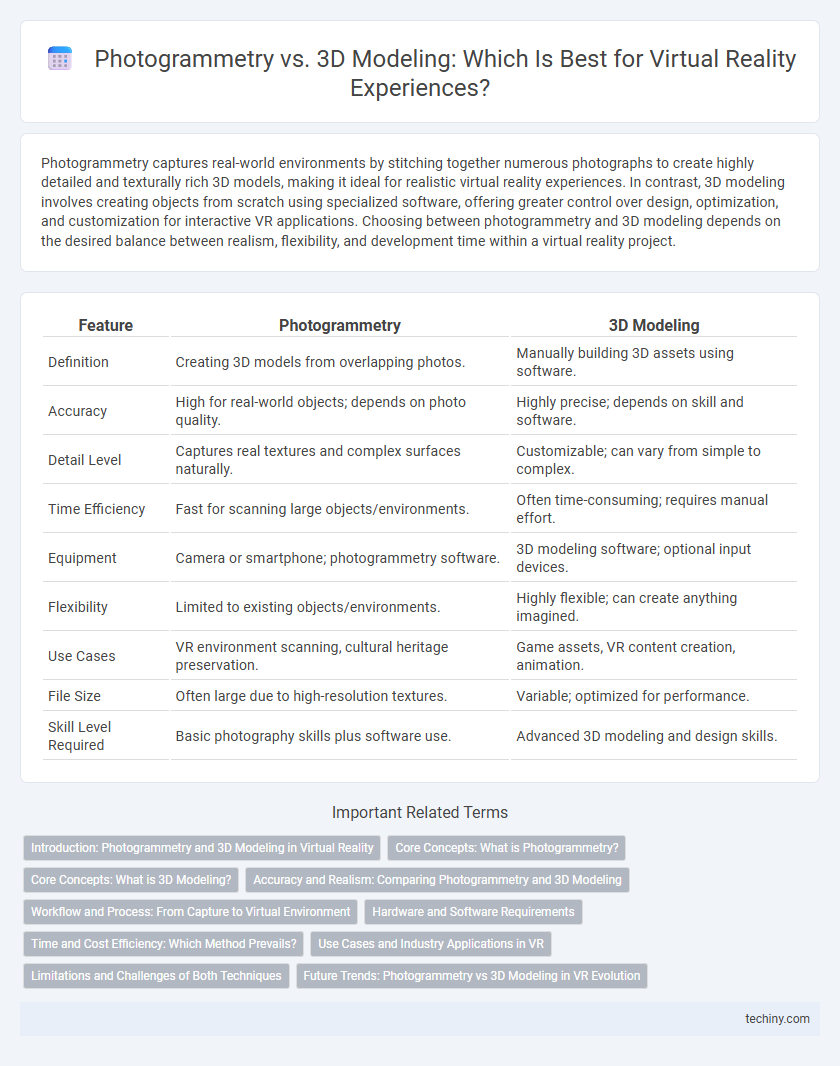Photogrammetry captures real-world environments by stitching together numerous photographs to create highly detailed and texturally rich 3D models, making it ideal for realistic virtual reality experiences. In contrast, 3D modeling involves creating objects from scratch using specialized software, offering greater control over design, optimization, and customization for interactive VR applications. Choosing between photogrammetry and 3D modeling depends on the desired balance between realism, flexibility, and development time within a virtual reality project.
Table of Comparison
| Feature | Photogrammetry | 3D Modeling |
|---|---|---|
| Definition | Creating 3D models from overlapping photos. | Manually building 3D assets using software. |
| Accuracy | High for real-world objects; depends on photo quality. | Highly precise; depends on skill and software. |
| Detail Level | Captures real textures and complex surfaces naturally. | Customizable; can vary from simple to complex. |
| Time Efficiency | Fast for scanning large objects/environments. | Often time-consuming; requires manual effort. |
| Equipment | Camera or smartphone; photogrammetry software. | 3D modeling software; optional input devices. |
| Flexibility | Limited to existing objects/environments. | Highly flexible; can create anything imagined. |
| Use Cases | VR environment scanning, cultural heritage preservation. | Game assets, VR content creation, animation. |
| File Size | Often large due to high-resolution textures. | Variable; optimized for performance. |
| Skill Level Required | Basic photography skills plus software use. | Advanced 3D modeling and design skills. |
Introduction: Photogrammetry and 3D Modeling in Virtual Reality
Photogrammetry in virtual reality uses high-resolution photographs to create detailed 3D models by capturing real-world textures and geometries, providing immersive realism. In contrast, 3D modeling involves designing objects through software, allowing for precise control over shapes, materials, and animations tailored to virtual environments. Both techniques enhance VR experiences by blending authentic visual fidelity with customizable design flexibility.
Core Concepts: What is Photogrammetry?
Photogrammetry is a technique in virtual reality that captures precise 3D models by processing multiple photographs taken from different angles, enabling accurate reconstruction of real-world objects and environments. Unlike traditional 3D modeling which involves manual creation of geometry and textures, photogrammetry automates the generation of detailed, realistic 3D assets directly from real-world data. This method is essential for creating immersive VR experiences with lifelike accuracy and rich visual detail.
Core Concepts: What is 3D Modeling?
3D modeling in virtual reality involves creating digital representations of objects or environments using specialized software to form polygons, vertices, and textures. Unlike photogrammetry, which reconstructs 3D models from photographic data, 3D modeling starts from scratch or references to design accurate and customizable assets. This process enables precise control over geometry, allowing developers to optimize models for performance and visual fidelity in VR applications.
Accuracy and Realism: Comparing Photogrammetry and 3D Modeling
Photogrammetry captures real-world objects with high accuracy by using multiple photographs to generate detailed 3D textures and geometries, enhancing realism in virtual reality environments. In contrast, 3D modeling relies on manual design, enabling customization but often sacrificing the true-to-life precision photogrammetry provides. Combining photogrammetry's accuracy with 3D modeling flexibility can optimize VR asset creation for both realism and interactive functionality.
Workflow and Process: From Capture to Virtual Environment
Photogrammetry captures real-world objects by processing numerous overlapping photos to create accurate 3D textures and meshes, excelling in detailed surface replication but requiring extensive image acquisition and cleanup. 3D modeling involves manually creating digital assets using software tools, offering greater control and flexibility in design but demanding significant skill and time investment during the modeling and texturing phases. Integrating photogrammetry-generated assets into virtual environments typically involves mesh optimization and retopology, while 3D models often undergo rigging and animation setup, defining distinct workflows from capture to deployment in VR applications.
Hardware and Software Requirements
Photogrammetry in virtual reality relies heavily on high-resolution cameras and advanced image processing software such as Agisoft Metashape or RealityCapture to reconstruct detailed 3D environments from photographs. In contrast, 3D modeling demands powerful computer hardware with robust GPUs and specialized software like Blender, Maya, or 3ds Max to manually create and manipulate digital objects. While photogrammetry emphasizes capturing real-world textures and geometries through multiple images, 3D modeling requires skilled artists and extensive computational resources for rendering and animation workflows.
Time and Cost Efficiency: Which Method Prevails?
Photogrammetry significantly reduces modeling time by automating the capture of real-world textures and geometry, minimizing manual labor compared to traditional 3D modeling. While 3D modeling offers greater control and precision for complex designs, it demands more time and skilled resources, increasing overall cost. For rapid development and budget-sensitive VR projects, photogrammetry often provides a more time and cost-efficient solution.
Use Cases and Industry Applications in VR
Photogrammetry excels in creating highly detailed, photorealistic virtual environments for VR applications in tourism, architecture, and cultural heritage preservation by capturing real-world textures and geometry. 3D modeling is preferred in gaming, simulation training, and product design within VR due to its flexibility in creating complex, interactive, and stylized assets from scratch. Both technologies complement each other, enabling immersive VR experiences that balance accuracy and creative control across diverse industries.
Limitations and Challenges of Both Techniques
Photogrammetry relies heavily on high-quality images and controlled lighting, making it challenging to capture complex or reflective surfaces accurately in virtual reality environments. 3D modeling demands skilled artists and significant time investment to create detailed, realistic assets, often resulting in higher production costs. Both techniques face limitations in real-time rendering performance and scalability, influencing the efficiency of virtual reality content creation.
Future Trends: Photogrammetry vs 3D Modeling in VR Evolution
Photogrammetry and 3D modeling are converging with advancements in AI-driven automation and real-time rendering for VR applications. Emerging trends emphasize photogrammetry's potential to create hyper-realistic environments by capturing intricate real-world details, while 3D modeling offers unparalleled flexibility in customizing virtual assets. Future VR evolution is likely to integrate both techniques to enhance immersion, streamline content creation, and improve scalability across diverse platforms.
Photogrammetry vs 3D modeling Infographic

 techiny.com
techiny.com